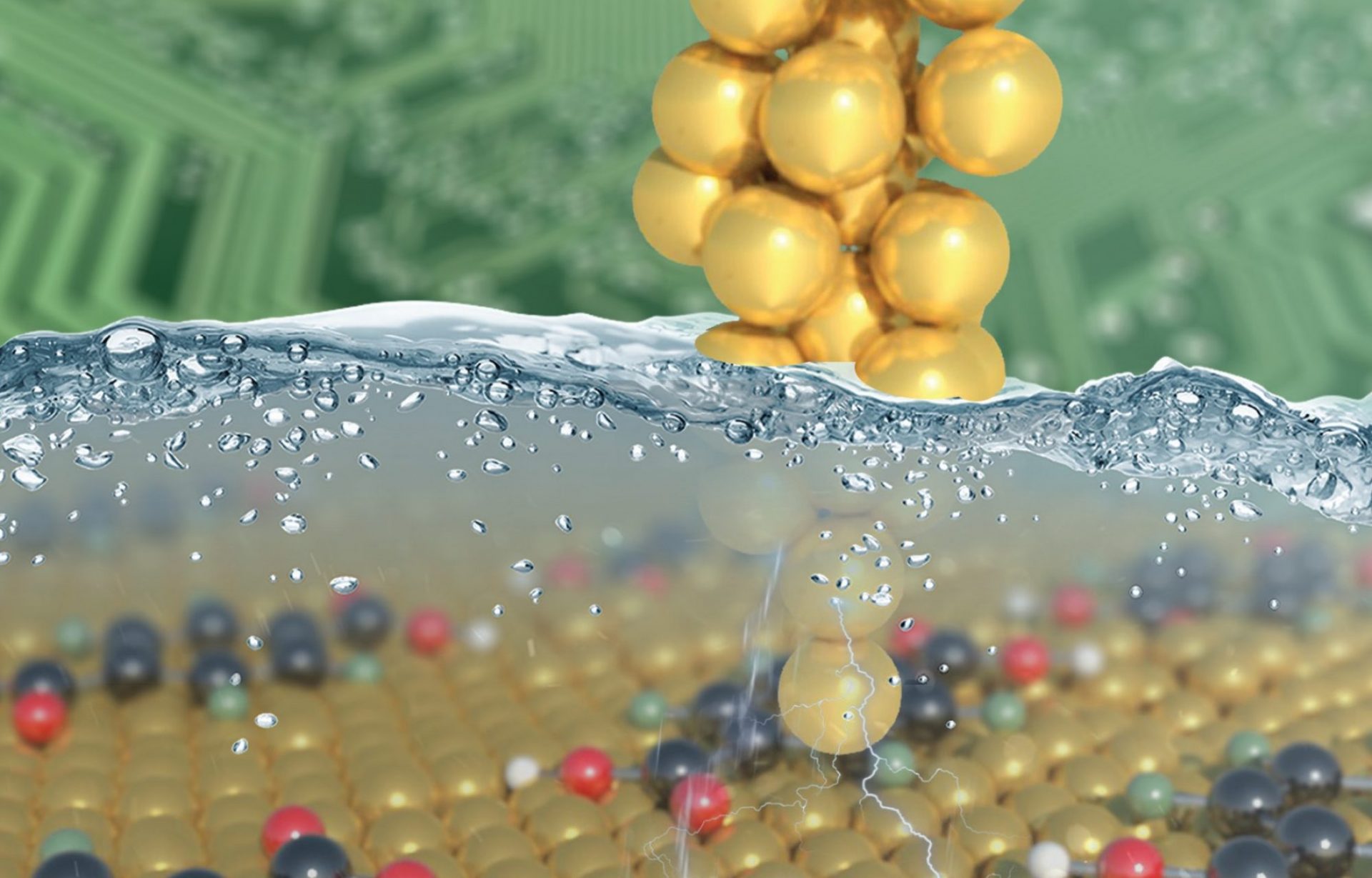Single Molecule Conductivity
Miniaturization of electronic devices (e.g., sensors and switches) is an important goal of molecular electronics. Acid base indicators show color changes with pH, revealing significant electronic structure perturbations and the possibility of major changes in the electrical conductivity of molecules. This hypothesis was verified using scanning tunneling microscopy (STM) break junction experiments on a series of triphenylmethane dyes, showing that the conductance of molecular junctions can be reversibly switched between ON and OFF states through changes in environmental pH.
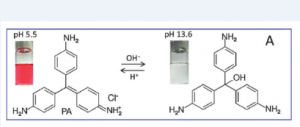
Previous Researchers:
– Sepideh Afsari, Zhihai Li
Orientation Controlled Conductivity in Single Molecule Junctions:
Molecular-Scale Electronic Devices usually are designed by wiring a single molecule between two metal electrodes. The stabilization provided by long-range ordered structures fixes the molecular geometry, allowing highly conductive Au/molecule/Au junctions to form by means of direct contact between the Π -system of benezene ring and the gold electrodes.The conductance of single mesitylene (0.12 G0) is much higher than conductivity of other simliar molecules. This approach enables the measurement of electrical conductivity of molecules through STM-BJ that do not have effective anchoring groups and cannot form single molecule junctions by conventional methods.
Related Papers
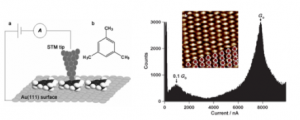
Previous Researchers:
–Sepideh Afsari
Previous studies:
– Contacts in Single Molecule Conductivity
Construction and Structural modification of 2D Networks:
We use external stimuli such as surface charge and environmental conditions to control adsorbate-substrate interactions and to tune dynamics at solid-liquid interfaces. Scanning Tunneling Microscopy (STM) and Atomic Force Microscopy (AFM) reveal the resulting phenomena:- Molecular diffusion and self-assembly- Molecular redox dynamics at electrode-electrolyte interfaces-Engineering well-ordered two-dimensional (2D) molecular networks with extended Π systems.
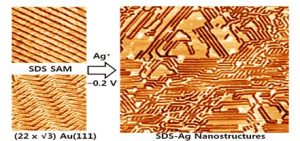
Previous Researchers:
–Tao Ye
Previous studies:
– Dynamics of surface reconstruction, lifting of reconstruction, nanoscale island decay/growth.
– Atomic and Molecular resolution STM/AFM at Liquid/Solid Interfaces (Yufan He, Tao Ye)
– Nanoscale Dynamics at Liquid/Solid Interfaces
– Potential driven phase transitions in Self-assembled Monolayers (SAM) (Kyoungja Seo)
– Read/Write/Erase nanolithography (Kyoungja Seo)
Nonlinear Optical Studies of Interfaces:
Spectroscopy
(Bijoya Mandal, Somaiyeh Dadashi)
Second order nonlinear optical techniques, e.g. Sum Frequency Generation (SFG) and Second Harmonic Generation (SHG), provide both ultrafast time resolution and interface selectivity. Current projects focus on vibrational SFG spectroscopy to reveal the structure of water at mineral surfaces and SHG spectroscopy to probe the overtone region of the O-H stretch of interfacial water.
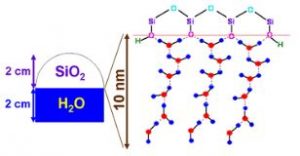
Dynamics
(Bijoya Mandal, Somaiyeh Dadashi)
Surface Vibrational Dynamics can provide details about the H-bonding environment of buried interfaces by measuring the vibrational relaxation times of O-H stretch. Current projects focus on the role of ions and acid-base equilibria at mineral/water interfaces.
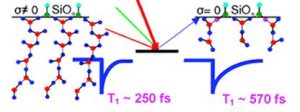
Previous Researchers:
– Stefan Piontek, Aashish Tuladhar
Previous studies:
– SHG Spectroscopy & Dynamics of Si, Ge, and SixGe1-x Interfaces (Dora Bodlaki, Vasiliy Fomenko, Julie Fiore, Catherine Faler)
Ion Adsorption and Water Behavior Near Solid Oxide/Water Interfaces By Molecular Dynamics Simulations:
(Ruiyu Wang, co-advised with Vincenzo Carnevale, ICMS, Temple)
Aqueous interfaces are involved in many important chemical processes. However, molecular-scale descriptions of interfacial chemistry are difficult to obtain by experimental techniques. Our group uses both classical and ab initio molecular dynamics simulations to investigate the microscopic structure of solid/water interfaces to answer fundamental questions, such as, what the water structure and dynamics are at the interfaces, how ions interact with water the solid and how the chemical properties of water is affected by the surface environment. We also use our findings to aid in the interpretation of vSFG spectra obtained in our lab.
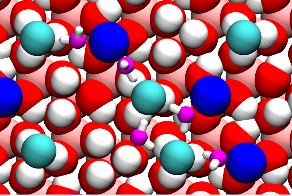
(Na+ (blue) and F- (green) at the alumina (0001)/water interface. Snapshots are obtained from MD simulations with NaF (left) and NaCl (right), respectively. Ion pairing of F- and Cl- are different. Water is not shown for clarity.
Plasmonics:
(Datta Venakta)
The collective excitation of free electrons in a metal nanoparticle results in a localized surface plasmon resonance (LSPR) which is a sensitive probe of nanomaterial and its local dielectric environment. We use the LSPR to detect chemical species and drive chemical processes. Current projects are: Plasmonic Sensing, Plasmonic Dynamics and Catalysis, Nano particle surface Chemistry.
Related Papers
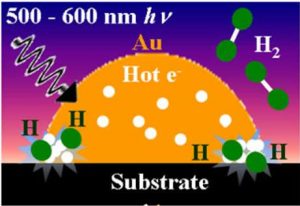
Previous Researchers:
– Edwin Ovalle, Thao Duong, Melissandre Richard
Nanomaterials:
(Isabella Goodenough, Datta Venakta, and Ryan McDonnell)
Conventional synthesis of nanoparticles, involve the use of precursors, reducing agents and surfactants.
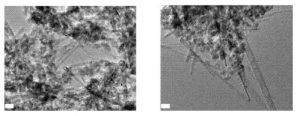
Properties of Carbon Nanotubes and other Carbon Materials:
Understanding the interaction between molecules and carbon nanotubes is key to a number of applications. We use NIR, Raman, FTIR, thermogravimetric analysis, TEM, AFM and TPD under vacuum conditions to probe molecular interactions with, and chemical functionality on, carbon materials. Environmental applications include development of solar energy harvesting devices as well as new and better sorbents for pollution control.
Related Papers
Previous Researchers:
– Mikaela Boyanich, Melissandre Richard, Dmitry Kazachkin
Novel Ultra-Broadband IR Laser Sources:
We are developing ultrabroadband IR laser sources providing pulses with bandwidths >1000 cm-1 in the ~1000 – 3000 nm wavelength range.
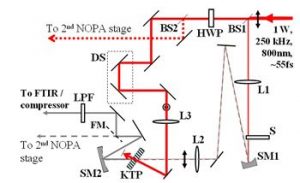
Previous Researchers:
– Dora Bodlaki
Previous studies:
– Transform-limited Picosecond Infrared OPA (Dora Bodlaki)
Fluorescence Detection of Surface Functionality:
FLOSS (Fluorescence Labeling of Surface Species) exploits the sensitivity of fluorescence and the specificity of covalent bond formation to identify and quantify low concentrations of surface functionalities. FLOSS can distinguish between COOH, OH and aldehyde groups and detect down to 1011 functional groups/cm2 on surfaces. This sensitivity is well beyond the detection limits of FTIR and XPS. FLOSS has been applied to understand SAM photoreactivity and is being extended to other materials.
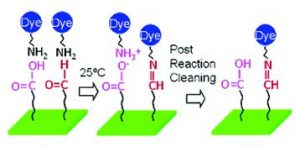
Previous Researchers:
– Tao Ye, Eric McArthur
Previous studies:
– Growth, Stability and Photoreactivity of Self Assembled Monolayers (Tao Ye, Eric McArthur)
Sensors:
Bio-Sensors
Detection of bio species (cells, proteins, antibodies, etc.) by surface immobilization on piezoelectric sensor devices.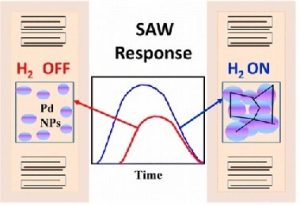
Previous Researchers:
– Devika Sil, Uduak Udoeyo
Hydrogen and Humidity Sensors
In collaboration with ASRD, we are developing surface acoustic wave sensors for NASA applications.
Related Papers
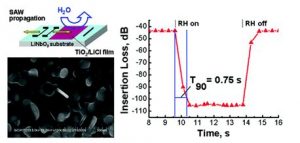
Previous Researchers:
– Andrii Buvailo, Yangjun Xing
